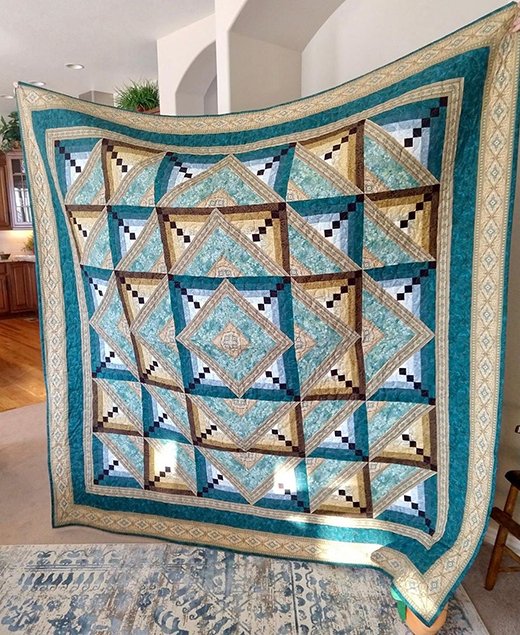Quilt making, a time-honored craft, offers a unique blend of artistic expression and practical skill. In the world of quilting, the Kashmir quilt stands out as a stunning representation of creativity and meticulous craftsmanship.
Inspired by the lush patterns and colors of the Kashmir collection, Jinny Beyer’s Kashmir quilt is a log cabin variation that resonates with the vibrancy of a stained-glass window. This article delves into the journey of creating such a masterpiece, guiding you through each crucial step, from conceptualization to the final stitch.
A Stained-Glass Window in Fabric: The Allure of the Kashmir Quilt
The Kashmir quilt, with its intricate design and vibrant colors, mirrors the aesthetic of a stained-glass window. This section highlights the unique design elements that make the Kashmir quilt a visual treat. The log cabin variation used in this quilt brings a dynamic, three-dimensional feel to the fabric, creating a play of light and shadow that mimics the luminescent quality of stained glass.
Threads of Tradition: The Historical Significance
Quilting, as an art form, has been a part of human culture for centuries, serving both utilitarian and aesthetic purposes. The Kashmir quilt, in particular, embodies a rich cultural heritage, drawing inspiration from the traditional patterns and colors associated with the Kashmir region. This section explores how the Kashmir quilt is not just a piece of art but a tapestry of history, connecting us to the past through every stitch and fabric choice.
Preparing for the Journey: Insights and Considerations
Embarking on the creation of a Kashmir quilt is as much about the process as it is about the outcome. This section provides valuable insights into the mindset and preparation needed for such a project. It discusses the importance of patience, precision, and the joy of seeing your creation take shape. This is where we set the stage for the actual creation process, ensuring that you are fully equipped and ready to begin this rewarding journey.

Full Pattern: Click Here
Materials
- Foundational Paper: Enough to create 20 copies for Block 1 and 16 copies for Block 2.
- Template Plastic: Transparent plastic for tracing and cutting template patterns.
- Various Fabric Pieces: Specific fabrics numbered 1 through 12, with different quantities and dimensions for strips, squares, and triangles as detailed in the pattern.
- Sewing Supplies: Rotary cutter, cutting mat, scissors, thread, sewing machine with a quarter-inch foot.
- Ironing Tools: An iron and ironing board for pressing seams.
- Binding Fabric: Reserved from fabric 10.
- Backing and Batting: Appropriate sizes for the quilt top.
Step-by-Step Instructions
- Preparing Foundations and Templates:
- Print and tape together the Block 1 and Block 2 foundations.
- Trace and cut out the templates on see-through plastic, marking all lines and dots.
- Cutting Fabric for Blocks and Borders:
- For each fabric type, cut strips of precise widths as described.
- Use the templates to cut the necessary shapes, marking dots on the wrong side for seam intersections.
- Assembling the Blocks:
- Sew the fabric patches onto the foundations in the order indicated.
- After sewing, press the blocks and trim the excess material.
- Constructing the Quilt Top:
- Join the blocks to form sections, carefully matching seams and points.
- Assemble the sections to create the full quilt top, ensuring the orientation of the blocks is correct.
- Adding the Borders:
- Sew the border strips together end-to-end to create long strips.
- Attach the borders to the quilt top, following the square quilt framing technique.
- Quilting and Finishing Touches:
- After removing paper foundations, layer the quilt with batting and backing, baste, and quilt as desired.
- Trim the quilt and attach the binding, ensuring a clean finish.
Harmony in Design: The Color Composition
Creating a quilt is akin to painting; each fabric piece is a brushstroke contributing to a larger picture. For the Kashmir quilt, the interplay of colors is central to its design. Selecting fabrics that offer a gradient of hues—from the lightest cream to the deepest teal—ensures that when pieced together, they create an illusion of depth and dimension.
This color composition invites the quilter to consider the impact of color value and placement, which is crucial for the quilt’s stained glass effect.
Precision Piecing: The Technical Tapestry
Assembling a Kashmir quilt requires a symphony of precision. Each cut and seam forms the foundation of the intricate pattern.Sewing the patches onto the foundations demands an exact quarter-inch seam allowance, careful alignment of points, and consistent pressing techniques.
The process may be methodical, but it’s within these details that the quilt’s character unfolds. Piecers are encouraged to embrace the meditative rhythm of stitching, allowing the design to emerge block by block.
The completion of the Kashmir quilt is a testament to the patience and passion invested in each stitch. It’s not just a blanket; it’s a piece of art that encapsulates the beauty of traditional craftsmanship infused with personal expression.
As the quilt takes its final shape, it bears the warmth of the hands that made it and the wonder of the eyes that behold it. May each quilter find joy in the journey and pride in the creation that unfolds from the fabric of imagination.
